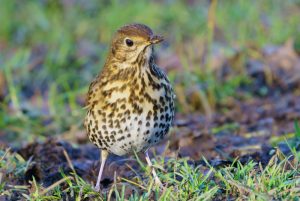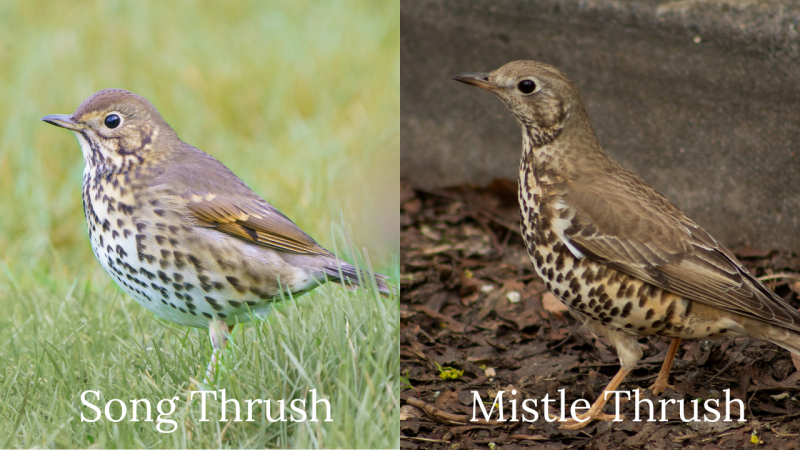- The Lifespan of Osteoclasts: How Long Do They Live?
- What is Monkfish average lifespan?
- What is Amberjack average lifespan?
- What is Sturgeon average lifespan?
- What is Barramundi average lifespan?
- What is Wahoo average lifespan?
- What is Shark average lifespan?
- What is Redfish average lifespan?
- What is Marlin average lifespan?
- What is Pompano average lifespan?
- What is Rainbow Trout average lifespan?
- What is Swordfish average lifespan?
- What is Anchovy average lifespan?
- What is Grouper average lifespan?
- What is Halibut average lifespan?
- What is Carp average lifespan?
- What is Pike average lifespan?
- What is Flounder average lifespan?
- What is Tilapia average lifespan?
- What is Sardine average lifespan?
Difference Between Song Thrush and Mistle Thrush

Thrushes are some of the most commonly spotted birds across Europe, and two of the most well-known species are the song thrush and the mistle thrush. While both birds share some similarities, there are several key differences that make it possible to identify one from the other.
In this article, we’ll explain how to tell mistle thrush from song thrush, answer why the mistle thrush is called that, and break down their differences in size, appearance, and behavior.
Basic Overview of Song Thrush and Mistle Thrush
The song thrush and mistle thrush are often confused due to their similarities. This table highlights key differences in size, color, and behavior to help you tell them apart.
| Characteristic | Song Thrush (Turdus philomelos) | Mistle Thrush (Turdus viscivorus) |
|---|---|---|
| Size | 20-23 cm | 26-29 cm |
| Plumage (Upper Parts) | Warm brown | Gray-brown |
| Chest Color & Markings | Cream-colored with dark, neat speckles | Paler chest with irregular dark spots |
| Habitat | Gardens, parks, woodlands | Open countryside, meadows, park lands |
| Song | Melodious, repeating phrases | Loud, harsh, often heard during storms |
| Behavior | More secretive when feeding, repetitive song | Bolder, often guards mistletoe trees |
By comparing these characteristics, it’s easier to tell a song thrush from a mist One of the easiest ways to tell a song thrush from a mistle thrush is by size. The mistle thrush is significantly larger, measuring between 26-29 cm, while the song thrush is more modest in size, at 20-23 cm. This difference in size also makes the mistle thrush appear bulkier, especially when perched.

Physical Differences: Song Thrush vs Mistle Thrush
One of the easiest ways to tell a song thrush from a mistle thrush is by size. The mistle thrush is significantly larger, measuring between 26-29 cm, while the song thrush is more modest in size, at 20-23 cm. This difference in size also makes the mistle thrush appear bulkier, especially when perched.
When it comes to plumage and markings, the song thrush has a warmer brown back and head, paired with a cream-colored chest marked by neat, dark speckles that often appear in rows. In contrast, the mistle thrush has a more grayish-brown back and a paler, almost white chest. The spots on a mistle thrush are less uniform and more irregularly spaced. From a distance, the mistle thrush’s colder tones provide a good visual clue, whereas the song thrush has a distinctly warmer appearance.
In terms of behavior, their flight patterns also differ. Mistle thrushes often glide with their wings held flat and have an upright posture, while song thrushes have a more direct, flapping flight. Feeding habits offer further distinction. Song thrushes are more secretive when feeding, often searching for snails and insects under leaves. Mistle thrushes are bolder and may even defend berry-laden trees, such as those with mistletoe, from other birds thrush. While their similarities might cause confusion at first glance, details like the mistle thrush’s larger size and bolder behavior or the song thrush’s melodic, repetitive singing can help you accurately identify each species in the field.

How Can You Tell Mistle Thrush from Song Thrush
To tell the difference between the two, there are a few key points to observe:
- Size: The mistle thrush is noticeably bigger and bulkier than the song thrush.
- Color and Spots: Song thrushes are warmer brown, with rows of neat speckles. Mistle thrushes are grayer, with more irregular spotting.
- Behavior: Song thrushes are more timid in the open, while mistle thrushes are often seen boldly defending their territories.
In terms of sound, song thrushes are known for repeating phrases in their song, while mistle thrushes produce a rattling, far-carrying call often heard during stormy weather.
Why Is a Mistle Thrush Called a Mistle Thrush
The mistle thrush gets its name from its strong association with mistletoe berries. These birds are known to vigorously guard mistletoe trees, as the berries are a valuable winter food source. Mistle thrushes will aggressively chase away other birds from their mistletoe feeding grounds, particularly during the colder months when food is scarce.
The bird’s name, therefore, reflects its connection to this plant, which is especially common in the European landscape where these birds reside.

The mistle thrush and the song thrush are both fascinating birds with unique traits, but they can be easily distinguished by their size, appearance, and behavior. The larger and bolder mistle thrush is often seen defending its territory, especially around mistletoe, while the smaller, more melodic song thrush prefers quieter surroundings with its repetitive singing.
Next time you’re birdwatching, look for the distinctive characteristics outlined here to easily identify these two beautiful species.



